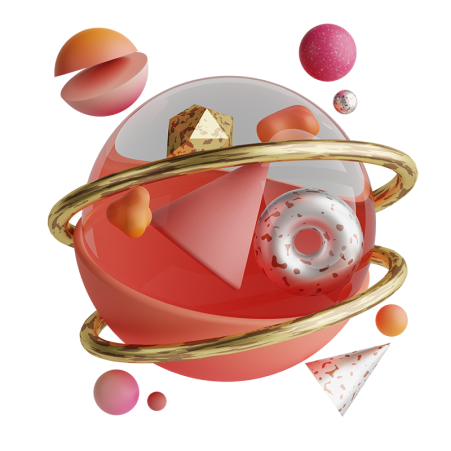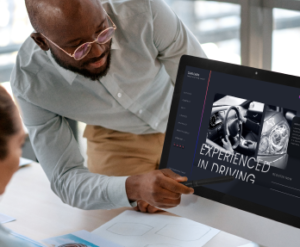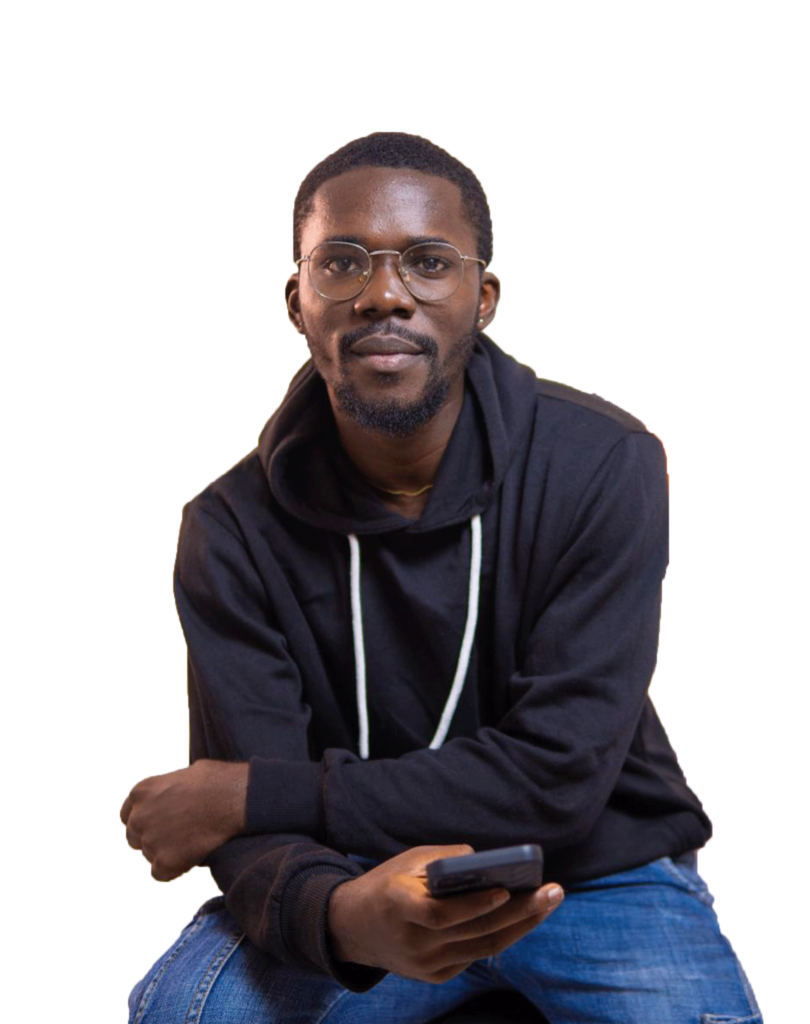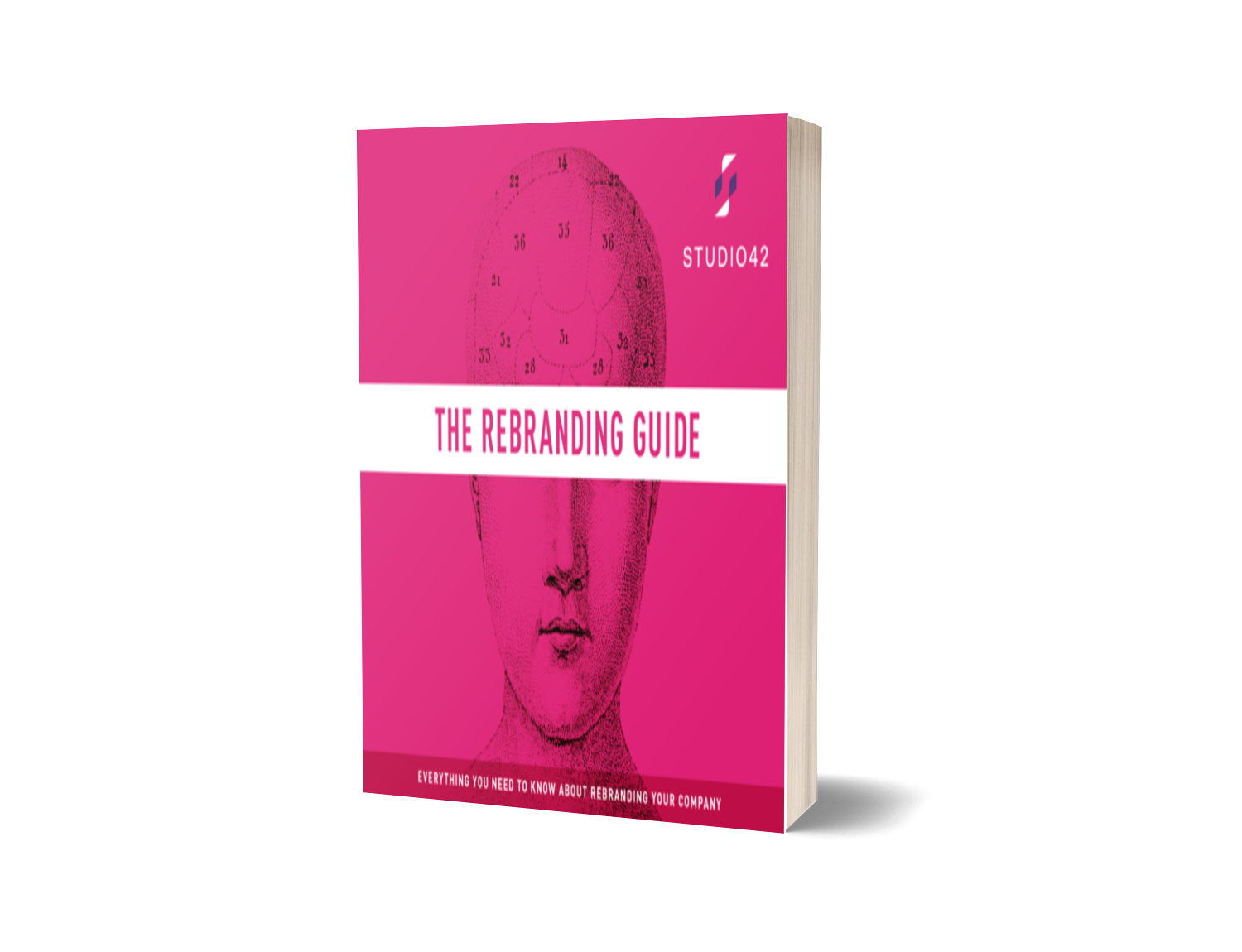
Studio42™ produces professional logo designs, graphic designs, websites & marketing materials that help you stand out from the competition.
Brand design is the process of crafting visual identity, your brand’s signature look and feel that is instantly recognizable in a crowded market landscape. To create a visual identity that refuses to be ignored, you need strategic, intentional brand design.

We specialize in brand design, helping businesses establish a strong and memorable identity. Our strategic approach encompasses logo design, brand guidelines, and storytelling, ensuring your brand resonates with your target audience. Ready to build a powerful brand? Reach out to us, and let’s begin the journey!
Whether for large or medium-sized companies, e-commerce providers or digital events and portfolios: We create websites that are memorable, always on the pulse of time and yet timeless. At Studio42, we plan, design and develop all website projects completely in-house.

A brand’s visual identity is the aesthetic embodiment of its positioning and personality. So, the most effective brand design is informed by research and guided by strategy. When brand design is effectively executed, the insights of research and strategy come to life in touchpoints like website, marketing collateral, packaging, presentations, etc.

Our web development team turns design concepts into fully functional websites. With a focus on responsive design and cutting-edge technology, we bring your online vision to life, delivering seamless user experiences across all devices. Ready to launch your dream website? Contact us today for a consultation!
Our creative graphic designers transform ideas into visual masterpieces. From stunning logos to eye-catching marketing materials, we’ll help you communicate your brand’s identity and message through compelling design. Let’s bring your vision to life – contact us for a design consultation!

Graphic design is a craft where professionals create visual content to communicate messages. By applying visual hierarchy and page layout techniques, designers use typography and pictures to meet users’ specific needs and focus on the logic of displaying elements in interactive designs, to optimize the user experience.
Web design is the process of planning, conceptualizing, and arranging content online. Today, designing a website goes beyond aesthetics to include the website’s overall functionality. Web design also includes web apps, mobile apps, and user interface design. Did you know that web design can have a huge impact on your performance in search engines like Google?

Our expert website designers craft captivating digital experiences, combining aesthetics and functionality to create user-friendly websites that leave a lasting impression. Elevate your online presence with our bespoke website design services. Get started on your stunning website today!
We build strong relationships and create Studio42 Values in everything we do. We treat every customer, and employee with respect and integrity
Team of Designers & Developers

Logo Designer

Web Developer & SEO Expert

Logo & brand identity designer

Founder/Creative Director
Founder Words

Design agencies, the visionary creators behind captivating digital aesthetics, molding your brand’s online identity for maximum visibility and engagement.
Here is a homemade lexicon crafted with love by the Studio42 team.
branding
[ branding ]
Brand from Old English brand (burning, a burning piece of wood, torch, sword) initially used to indelibly mark items such as furniture and pottery.
DEFINITION
Branding encompasses all the tangible or intangible factors that allow a company, a product or a service to distinguish itself and be remembered. Elements such as mission, scope of action, values or personality are fundamental to branding, all of which contribute to the brand platform. Beyond verbal or visual representations, brand identity can also translate through other senses like smell or sound, etc.
Branding comprises everything from communication and advertising to the product and services themselves. Often, branding depends on a set of recurring elements, such as a logo, signature, color palette, typography, style of photography or video, which sets the tone for targeted customers.
At Studio42, we create digital products and services with branding in mind. Uncovering and telling a brand’s story is pivotal to our process. For each project (and especially for digital products), we focus on creating an original visual language that conveys the brand values and purpose.
USEFUL QUOTE
“Design is the silent ambassador of your brand.”
Paul Rand
color
[ color ]
Color from latin color linked to the group celare (to hide, to conceal) conveys the idea that color covers and hides the surfaces of objects and thus alters reality
DEFINITION
Color is an illusion created by wavelengths of light bouncing off objects. We experience color thanks to the retina in our eyes. It could be challenging to categorize color, hence the different approaches to this complex concept.
For example, in chemistry, scientists analyze color at the molecular level, studying how different wavelengths of light are absorbed and reflected. However, in biology, scientists use a physiological approach and endeavor to understand how color is perceived through the human or animal eye. In psychology, experts leverage a cognitive approach to associate colors with emotions or concepts. Across the spectrum, there is also the artistic approach, where artists organize, classify and name colors based on a painter’s whim and practice. In a nutshell, color perception can be both subjective and cognitive.
In design, and more specifically at Studio42, color is a key component of the products and environments we create. Color can be a vector of identity, meaning and information. It also serves to differentiate the objects and interfaces we design. Since color is often associated with a given material or platform, such as paper, textile or screens, we select color nuances based on the context a design will be used. We build color palettes to convey emotion and identity.
USEFUL QUOTE
All colors are the friends of their neighbors and the lovers of their opposites.
Marc Chagall
design system
[ design system ]
Design originally stems from latin designare (to mark, to draw, to indicate) and System from latin and ancient Greek sýstêma (combination, assembly, system).
DEFINITION
In the field of digital interface design, a design system is a design guide that specifies the elements of visual language structuring a graphic user interface. Design systems comprise the fundamentals of identity such as colors, typographic styles, interface components, templates, grids, structuring rules, dimensions, interaction principles, styles and behaviors of buttons, links and icons. These elements are the outcome of a modular and systemic design.
A design system allows designers and developers to ground their decisions when building the different screens for their products. The objective of the design system is to guide choices and guarantee coherence while designing complex products. This facilitates the team’s work in a context where these products constantly evolve over time.
USEFUL QUOTE
“Styles come and go. Good design is a language, not a style.”
Massimo Vigneli, Italian Designer
elegance
[ elegance ]
Elegance from latin elegantia (how to select).
DEFINITION
Elegance is characterized by simplicity and purity. It is the polar opposite of ostentation, overload, or the search for effect. As such, elegance refers to what is essential. In design, elegance goes beyond an aesthetic appreciation. It also refers to the way a designer makes decisions and approaches complexity.
At Studio42, elegance (especially French elegance) is at the heart of our approach. We guide our clients in their choices throughout the design process. With elegance, we can resolve issues that companies struggle to address.
USEFUL QUOTE
“Perfection is obtained, not when there is nothing more to add, but rather when there is nothing left to take away.”
Antoine de Saint-Exupéry
innovation by design
[ innovation by design ]
Innovation (act of introducing something new) originated from the latin innovatio (renewal) and Design from latin designare (to mark, to draw, to indicate)
DEFINITION
From a detailed understanding of usage, needs, and technology, innovation by design consists of proposing solutions that make sense from a social and economic point of view. Innovation does not derive from technology but rather, from a particular vision of the market or society.
It is often said that innovation is successful when it is supported by the people it addresses. Otherwise, it is considered an invention. The innovation by design approach allows us to envision the future and to identify the technology needed. We visualize the process with a concrete representation of the potential products, processes, or systems.
At Studio42, we consider all facets of a problem through the technical, economic, societal, and behavioral lens. Afterwards, we pinpoint opportunities, which can include new needs, markets and products. We thus formalize an initial concept and prototype the ideas to determine its appeal, viability and feasibility.
USEFUL QUOTE
“Design doesn’t produce only one solution, but rather, several. It incites debate, proposes alternatives and offers original definitions in our lives and future lifestyle.”
Anne Asensio, Industrial Designer
interaction design
[ interaction design ]
Interaction from the Latin prefix inter- (between) and actio (ability to act, activity) and design from English to design, to conceive, itself from the Latin designare (to mark with a sign, to draw, to indicate).
DEFINITION
Interaction design is imagining, creating, and designing all the elements that govern daily interactions with the objects and systems surrounding us. A part of experience design, interaction design remains a practice that underlines our relationship to things and objects. In a nutshell, interaction design defines a product’s behaviors when we use or come in contact with it. It also defines how it behaves with other products in a given system. Interaction design means connecting to ou surroundings and tuning into the emotions the user will feel when listening to a sound, discovering information or touching a button, all of which are essential parts of the user experience.
USEFUL QUOTE
“If we want users to like our software, we should design it to behave like a likeable person: respectful, generous and helpful.”
Alan Cooper
moodboard
[ moodboard ]
Mood from Old English mood meaning mind in poetry, also heart, spirit or courage.
DEFINITION
A moodboard is an inspiration board composed primarily of visual and graphic references, and sometimes, of materials and words. It is a summary that sparks a project’s future visual or experiential identity and sets the initial tone.
Most of the time, moodboards intervene at an early stage of the project. This specific form of “collage” conveys a first intention and shares a universe or snapshot image with the project’s stakeholders. It also provides the designer with a reference document that guides the creation process.
USEFUL QUOTE
“Design is thinking made visual.”
Saul Bass. Graphic designer.
prototype
[ prototype ]
Prototype from greek prōtotypon (a first or primitive form) made up of prōtos (first ) and typos (impression, mold, pattern).
DEFINITION
“Prototype” initially designates a product’s first functional and final appearance before launching its mass production in the industry. Today, in different creative fields, such as design, this term refers to models, sketches, or scenarios. In this vein, the prototype is a partial or complete draft of a designed product or service. Its purpose is to test and validate conceptual and usage hypotheses before technical development or market implementation. This includes but is not limited to the volume or aesthetic line of a space, the interest in a new service, the usability of a mobile application interface, etc.
At Studio42, prototypes are the core of every project we design for our clients. It allows business strategies to come to life in the form of new services or product experiences.
USEFUL QUOTE
“Prototyping at work is giving form to an idea, allowing us to learn from it, evaluate it against others, and improve upon it.”
Tim Brown
strategic design
[ strategic design ]
Strategy from the Greek stratos (army) as well as agein (to lead), often defined as the art of command and design derived from the Latin designare (to mark with a sign, to draw, to indicate).
DEFINITION
Strategic design is an approach which taps into design tools and techniques such as inspiration research, analysis, co-creation, prototyping, and testing. Strategic design requires creativity to define strategy and a company’s vision. The purpose of strategic design is to facilitate strategic decision-making and stakeholder alignment in the following cases: define an organization’s 10-year plan, illustrating its innovation strategy as well as its new innovation model.
Let’s remember that strategic design should not be confused with design strategy, which refers to the choices and orientations related to design taken within the framework of a design program or project.
USEFUL QUOTE
“The designer is an inventor of scenarios and strategies. Thus, the project should be carried out throughout the territories of imagination while creating new stories, new fictions, which will increase the thickness of reality.”
Andrea Branzi
usage scenario
[ usage scenario ]
Scenario from the Italian scenario, designates the setting of a play and then the “description of the staging”.
DEFINITION
A usage scenario describes the user’s journey through a service or product, which comprises the course of their actions in regards to these services or products in upstream and downstream use. It is a powerful, narrative tool that crystallizes a user’s experience. It is also a means for the various project stakeholders to align objectives. It can take many forms, from a simple story to a storyboard or video. In the case of an interface or digital product design process, the usage scenario is the raw material that allows us to prototype the user journey with screens.
Generally speaking, at Studio42, we co-create the usage scenario with our partners. To do this, we leverage the previously created personas to envision an experience best suited to the users’ needs. Although it is a collective story, the usage scenario is meant to be as credible and realistic as possible. Just like personas, the usage scenario can stem from a field study, the customer’s knowledge or the imagination of the stakeholders.
USEFUL QUOTE
“The designer is an inventor of scenarios and strategies. Thus, the project must be exercised on the territories of the imagination, to create new stories, new fictions, which will increase the thickness of reality.”
Andrea Branzi
business design
[ business design ]
Business from Old English word bisignes (care as well as occupation) and design (to conceive), originally from latin designare (to mark, to draw, to indicate).
DEFINITION
Business design is a design practice whose goal is to create, prototype and test new businesses. The ideation and prototyping phases focus on identifying and testing the value proposition before diving into the detailed design of a service, product or experience.
In a business design project, the prototypes created—press release, sales presentation—tend to illustrate the value delivered to the customer rather than how it would be delivered. This phase allows us to to gauge real customer needs and quickly roll out a priced, value generating product/service.
At Studio42, Business Design is the first phase of the innovation process, preceding the product or service design phase.
creation
[ creation ]
Creation from latin creatio (to create, to name) and its verb creare (to create, to reproduce, to beget, to produce).
DEFINITION
If we look beyond the divine and the laws of nature, creation is a human action. Creation consists of producing something new, using the resources of the real world. It is present in many activities and practices, including design, fashion, architecture, science research, music composition, cooking, illustration and writing. It also takes various forms, from material and immaterial to even intellectual, event-based or industrial productions, etc. And it offers a new relationship with reality to satisfy human needs. Creation can be spurred by a need of social recognition, aesthetic appreciation, storytelling, philosophical reflection, political stance, technical comfort, etc.
At Studio42, the creation process inspires us and continually feeds our design practice. In our creation process, we leverage techniques from fine arts and design, such as drawing, visual narration, paper models, interactive prototyping, illustration, graphic design, animation, etc. From exploration to convergence, our clients and users participate in our solutions and creation process to imagine accessible, elegant, meaningful and valuable products and services.
USEFUL QUOTE
« I do not think there is any thrill that can go through the human heart like that felt by the inventor as he sees some creation of the brain unfolding to success… such emotions make a man forget food, sleep, friends, love, everything. »
Nikola Tesla
design thinking
[ design thinking ]
Design originally stems from latin designare (to mark, to draw, to indicate) and Thinking (the process of reasoning)
DEFINITION
The term “Design thinking” is quite popular. It is often used to designate an innovation methodology, which ranges from empathic immersion to implementation of a solution through prototyping and testing. In reality, the term design thinking refers more broadly to all the processes, approaches and methods used by designers. Design thinking also extends to engineers, architects, urban planners and graphic designers to create new concepts or systems. The outcome includes but is not limited to graphic identity, spaces, products and services.
At Studio42, we see design thinking as a precise innovation methodology that allows us to seamlessly coordinate the skills and phases necessary for project success. It is based on the fundamental design principles used by designers: competence and multidisciplinary for business/technology/users, prototyping and testing for rapid iterations, creative confidence…
USEFUL QUOTE
“Design is not merely a craft-based skill but should be considered a knowledge-based discipline in its own right, with rigorous methodology and research principles incorporated into the design process.”
Bruce Archer
experience design
[ experience design ]
Experience stems from latin experientia (test, trial, attempt, experience that we did or practiced) and Design originally derives from latin designare (to mark, to draw, to indicate)
DEFINITION
Experience design is a practice that aims to create products, services, or spaces, taking into account the entire customer journey. The experience starts from the moment a client first encounters the service, with campaigns or the website. It continues as the client interacts with the target and includes all the steps related to the use of the service itself.
Experience design is often perceived as a tautology by some designers, however the term “experience design” refers to a specific set of practices and skills. Indeed, it focuses on identifying the real needs and expectations of users before designing and orchestrating a memorable experience. The experience itself involves “touch points” in several mediums: digital (website, mobile applications), paper (paper tickets, brochure), spatial (lobby, entrance) and physical (connected objects, signs)..
USEFUL QUOTE
“We see our customers as invited guests to a party, and we are the hosts. It’s our job every day to make every important aspect of the customer experience a little bit better.”
Jeff Bezos
inspiration
[ inspiration ]
Inspiration from latin inspiratio which initially has both a physiological meaning (action from air in the lungs) and a figurative meaning (divine breath that compels a particular action).
DEFINITION
Inspiration is an essential intellectual component within the creative process. Required upfront or during a project, the process of inspiration means immersion to understand the challenges and constraints within the framework. Inspiration also fuels the project with creative orientations or solutions. This process allows the designer to come up with creative concepts or solidify intentions.
At Studio42, the inspiration process is an exploration that we address in several dimensions, ranging from art and graphic design to imagination and fiction. We also include anthropological research to investigate users’ aspirations. In this vein, we conduct field visits and study creative, technology and business trends.
USEFUL QUOTE
“You can’t wait for inspiration. You have to go after it with a club.”
Jack London
interface
[ interface ]
Interface from English inter- (between) and face (face, figure, shape).
DEFINITION
An Interface is an instrument which shapes the relationship between man and technology. An interface can be tactile, vocal, haptic, interactive or graphic.
At Studio42, interfaces are designed with users in a workshop before being refined by digital designers to create beautiful experiences and valuable digital products.
USEFUL QUOTE
“When designers replaced the command line interface with the graphical user interface, billions of people who were not programmers could make use of computer technology.”
Howard Rheingold
persona
[ persona ]
Persona from the latin persona (mask, character) or from the ancient Greek « prosopo » used in ancient theater to represent a social role (synonym: figure, archetype).
DEFINITION
In a user-centric approach, the persona is a tool which makes the user of a product or service “tangible”. There are two types of personas: personas resulting from a research phase (directly inspired by one or more interviewees) and personas co-created with the stakeholders of a project. Using personas in a project can serve several means, such as aligning stakeholders or acting as a starting point for realistic usage scenarios.
USEFUL QUOTE
“There is an unconscious propriety in the way in which, in all European languages, the word “person” is commonly used to denote a human being. The real meaning of persona is a “mask”, such as actors were accustomed to wear on the ancient stage ; and it is quite true that no one shows himself as he is, but wears his mask and plays his part. Indeed, the whole of our social arrangements may be likened to a perpetual comedy.”
Arthur Schopenhauer
service design
[ service design ]
Service from the Latin servitium referring to servitude, applied initially to individuals before shifting towards the use and usefulness of a device and design from the Latin designare (to mark with a sign, to draw, to indicate).
DEFINITION
Synonymous with product design or industrial design, which consists of designing manufactured objects that are marketed industrially, service design entails designing or improving services. This can extend to all activities that provide an intangible good or service. Service design is an extensive practice affects many sectors: mobility (public transport, car rental, etc.), personal services (childcare, home help, education, etc.), but also entertainment (video or music on demand), or public services.
The design practice has adapted to this new intangible “consumer object” which is a service. To take into account all the dimensions that are specific to it, the client of a service is called a “user”, as opposed to a “consumer”. The specificity of this service builds on the many interactions between its users and its company through physical or digital interfaces.
To address this complexity, service design leverages a user-centric methodology as well as a service delivering process in order to identify the company’s pain points. A multidisciplinary team often carries out this holistic approach in order to understand the users’ needs and the company’s constraints or means. Service design maps out the desired experience and implements the different touch points or “components” of this experience, be it human, physical or digital (websites for information or administrative procedures, paper forms, reception areas, etc.)
USEFUL QUOTE
“Service design is all about making the service you deliver useful, usable, efficient, effective and desirable.”
UK design Council
typography
[ typography ]
Typography from the Greek typographia, composed of typos (print, impression) and graphio (to write).
DEFINITION
Typography emerged during the great printing revolution. It initially referred to the art of arranging letters and words using “type” (formerly small pieces of lead). Today, typography goes beyond printing and paper. It dominates our screens and has become the object of multiple interactions.
At Studio42, typography refers to the design of a font, from the shape of the characters themselves to the space between the letters. It is a codified vehicle of style and conveys the identity of a brand or a service. Indeed, typography also has functional characteristics: it improves readability, impacts reading speed, and affects comfort. Typically, the typography used on paper does not have the same characteristic as that used on screens.
USEFUL QUOTE
“Typography is two-dimensional architecture, based on experience and imagination, and guided by rules and readability.”
Hermann Zapf, Typographer
user research
[ user research ]
Research from Old French cerchier (to try to discover something) and the prefix re- (again) and User derived from the verb to use (who uses).
DEFINITION
User research is an opportunity to meet potential or current users of a product or service. Whether quantitative or qualitative, the objective is to understand them. Designers observe and question users about their needs, understand their habits, and learn a little more about their daily lives.
At Studio42, user research is carried out upstream in the form of qualitative interviews and in-situ observation. We go beyond the What and How and explore the Why. This immersion phase can be conducted alongside user tests. For example, we can test different iterations of a design project and hypothesis we make upstream.
USEFUL QUOTE
“Pay attention to what users do, not what they say.”
Jacob Nielsen
co-design
[ co-design ]
Co-design from the latin co (with) and design (to conceive), originally from latin designare (to mark, to draw, to indicate).
DEFINITION
Co-design is a dynamic that harnesses collective intelligence in innovation projects. Essentially, co-design allows users to explore and define concepts to better develop products and services.
At Studio42, co-design workshops mean more than having clients participate during the design phase. Indeed, co-design entails the active participation of users during the inspiration and exploration phase of an innovation project. We collaborate with users via workshops or individual interviews to come up with the best solutions for their needs.
USEFUL QUOTE
It is the long history of humankind (and animal kind, too) that those who learned to collaborate and improvise most effectively have prevailed.
Charles Darwin
Design
[ design ]
Design originally derived from latin designare (to mark, to draw, to indicate).
DEFINITION
Design is a practice that entails conceiving, creating, inventing, or improving products, services, or experiences. Ideally, design should benefit the most significant number of people. During the design phases of formalization, representation, scripting, prototyping, and experimentation, designers leverage their intuition and reason. Design can ultimately reveal new ways of cohabiting, communicating, working, or living.
USEFUL QUOTE
“To design is to devise courses of action aimed at changing existing situations into preferred ones.”
Herbert Simon, Nobel Prize In Economics
digital product
[ digital product ]
Digital from latin digitalis (finger or toe) used to count numerals under ten with fingers, derives from digits used to characterize computers running data in the form of digits (opposed to analogue) and Product from the latin verb producere (to grow).
DEFINITION
A product is a material or non-material good of varying scale. It can be commercialized after being designed and produced to meet a need and or add value to the user.
Given the transition from a physical and industrial society to a service society, as well as the rise of new technologies, some products have been digitized to become part of our daily lives. This includes but is not limited to mobile applications, online services and software. Digital products differ from physical products by user experience, scale, usability and convenience.
Even though they share a similar creation process—market development for physical design and production for digital design—there is an essential difference. While the launch of a physical product in the market implies the end of the design intervention, a digital product continues to evolve after market launch. Indeed, a digital product grows, matures and reinvents itself. Ultimately, it is the designer’s role to anticipate these changes.
USEFUL QUOTE
“Don’t find customers for your products, find products for your customers.”
Seth Godin
ideation
[ ideation ]
Ideation from Greek idea ‘form, pattern’ (from the base of idein ‘to see’) and latin -atio (designating action of).
DEFINITION
The purpose of the ideation phase within an innovation project is to immerse oneself in a problem. This allows the project’s various stakeholders to envision solutions that correspond to identified problems. In ideation, the concepts that emerge address real user needs and strategic challenges for the company.
At Studio42, this phase entails ideation workshops involving the project’s stakeholders. For example, participants would include Design (Studio42), R&D, Sales, Marketing, etc.
USEFUL QUOTE
«Everyone is in love with their own ideas.»
Carl Jung
interaction
[ interaction ]
Interaction from the English inter- (between) and action (exercise of the capacity to act).
DEFINITION
An interaction is a phenomenon produced by an exchange between two objects (inert or living), which impacts both the sender and the receiver. An interaction can induce different kinds of feedback, including but not limited to sound, visual, olfactory, and/or physical feedback. Indeed, interaction can be considered the start of communication between two objects down the line.
At Studio42, interaction is one of the design fields we investigate when we design digital services and products. It enables us to define how people, products, services, and systems interact with each other. That’s why we make sure users get appropriate feedback when interacting with a product to make them feel more comfortable. We strive to minimize the number of interactions with an interface to create a seamless experience. In our studio, we brainstorm new and enticing interaction models for meaningful user experiences. Interaction is one of the main playing fields for designers to investigate the emotional impact on users for a product or service.
USEFUL QUOTE
“My goal is to simplify complexity. I just want to build stuff that really simplifies our base human interaction.”
Jack Dorsey – Twitter founder
intuition
[ intuition ]
Intuition from latin Intuitio, the ability to understand or know something immediately based on your feelings rather than facts
DEFINITION
Intuition is an idea that springs up without us really knowing why. It is often the result of an intimate and sensitive knowledge of the environment.
In design, intuition is the ability to detect and perceive needs and problems in a new context. Intuition is also the capacity to foresee concepts, ideas, forms, or technical solutions.
At Studio42, intuition is often based on the designers’ own experience and on various sources of inspiration from immersion phases (benchmarking of similar solutions, user or expert interviews) or regular monitoring (exhibition visits or expert conferences). The first intuition is embodied by concepts before being prototyped and tested. One of design’s greatest strengths is to reconcile intuition and reason.
USEFUL QUOTE
“It is by logic that we prove, but by intuition that we discover. To know how to criticize is good, to know how to create is better”
Henri Poincaré, Mathematician.
product design
[ product design ]
Product, past participle of the word produce, from the Latin producere (to lead forward) and design derived from the Latin designare (to mark with a sign, to draw, to indicate).
DEFINITION
Product design entails imagining, creating, conceiving or improving products intended to be distributed on the market. Product design is a term that originated in the design industry and initially referred to the design of physical objects. Much more than the drawing of a shape or a volume, product design integrates different parameters such as the manufacturing process, the production costs, the materials, their properties, as well as the entire life cycle of the product, from its launch to its death.
Today, the product design approach no longer applies to solely physical objects but also to interfaces such as applications or service devices with a digital dimension (digital products).
USEFUL QUOTE
“Design is not just what it looks like and feels like. Design is how it works.”
Steve Jobs
simplicity
[ simplicity ]
Simplicity from the Latin simplicitatem, which refers to the state of being simple, frankness, openness, artlessness, candor, directness.
DEFINITION
Simplicity is most often equated with the notion of clarity or efficiency. Yet, as a designer, the search for simplicity is central to our practice. It is a balance achieved by removing everything unnecessary and adding everything that makes sense. Whether its referring to simplicity of a form, the simplicity of use, or even execution, it is a founding principle and for some, a quest verging on the exquisite.
Many companies like Braun or Apple have put design and simplicity at the heart of their strategy. But beyond a simple design bias or a founding principle of the designer, simplicity is a real need for users. Simplicity is all about the user, sparing the time and attention needed to offer a quality experience.
USEFUL QUOTE
“Simplicity is the ultimate sophistication.”
Leonardo da Vinci
ux/ui design
[ ux/ui design ]
UX is the acronym for User Experience, which appeared in the 1990s and was popularized in the 2000s by Donald Norman. UI is the English acronym for User Interface.
DEFINITION
In digital product design, UX refers to “user-experience design” while on the other hand, UI refers to “user interface” design, meaning the design of visual aspect of a digital product. These two disciplines may be carried out by designers with specialized profiles: ux designers (and sometimes researchers) for UX, graphic designers for the ui part.
At Studio42, we consider ourselves experience designers in the broadest sense. Designing a service or a product means taking into account the physical and digital aspects beyond the screen, and beyond the typical skillset. Thus, each designer is responsible for a project and its creative vision, handling all dimensions of experience design, from user research to graphic design. This is why we generally avoid to separate UX and UI in our digital design practice. We believe an experience can only be conceived in its entirety by tapping into its business, human and creative dimensions.
USEFUL QUOTE
“Design isn’t crafting a beautiful, textured button with breathtaking animation. It’s figuring out if there’s a way to get rid of the button altogether.”
Edward Tufte

EVERYTHING YOU NEED TO KNOW ABOUT REBRANDING YOUR COMPANY.